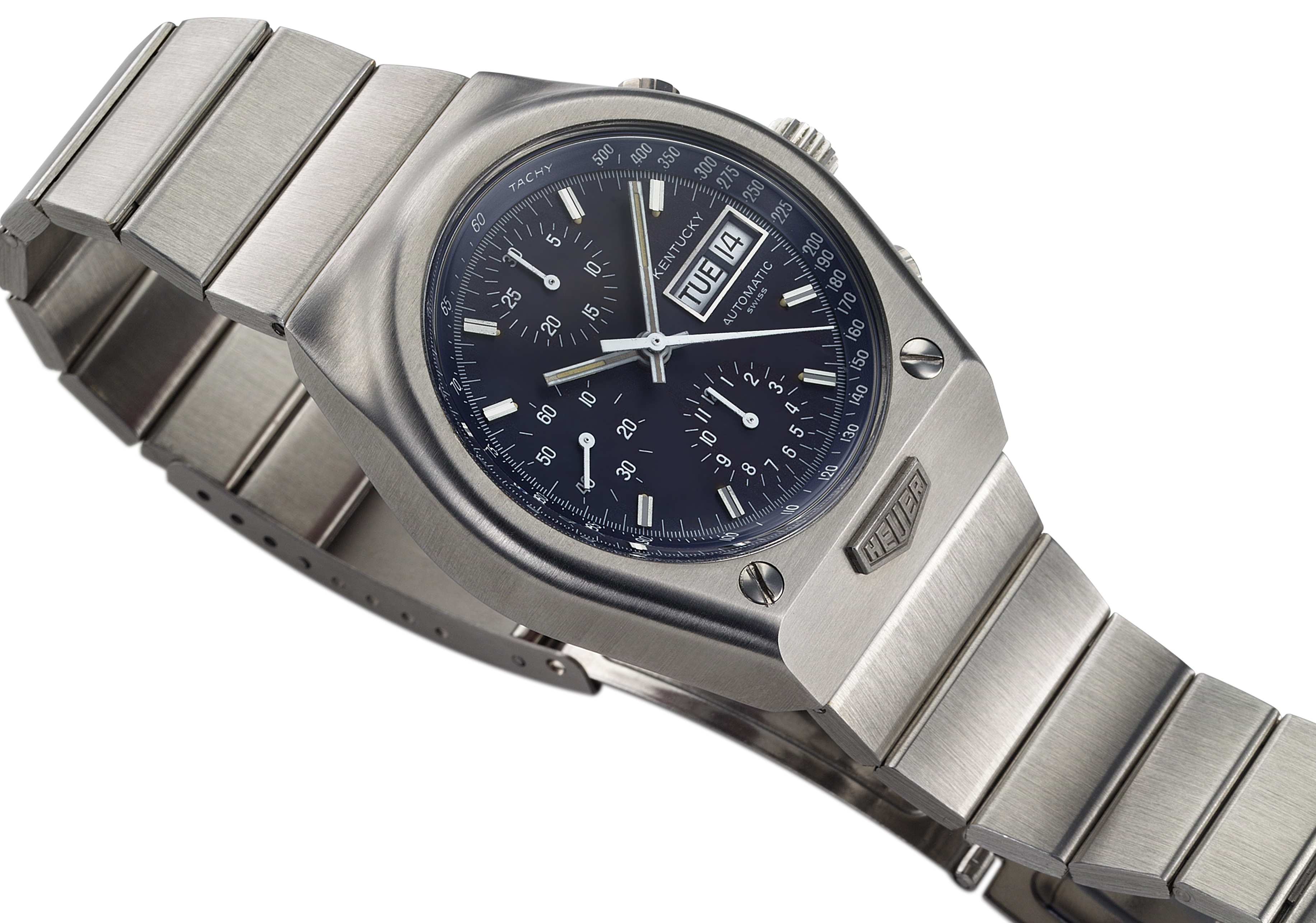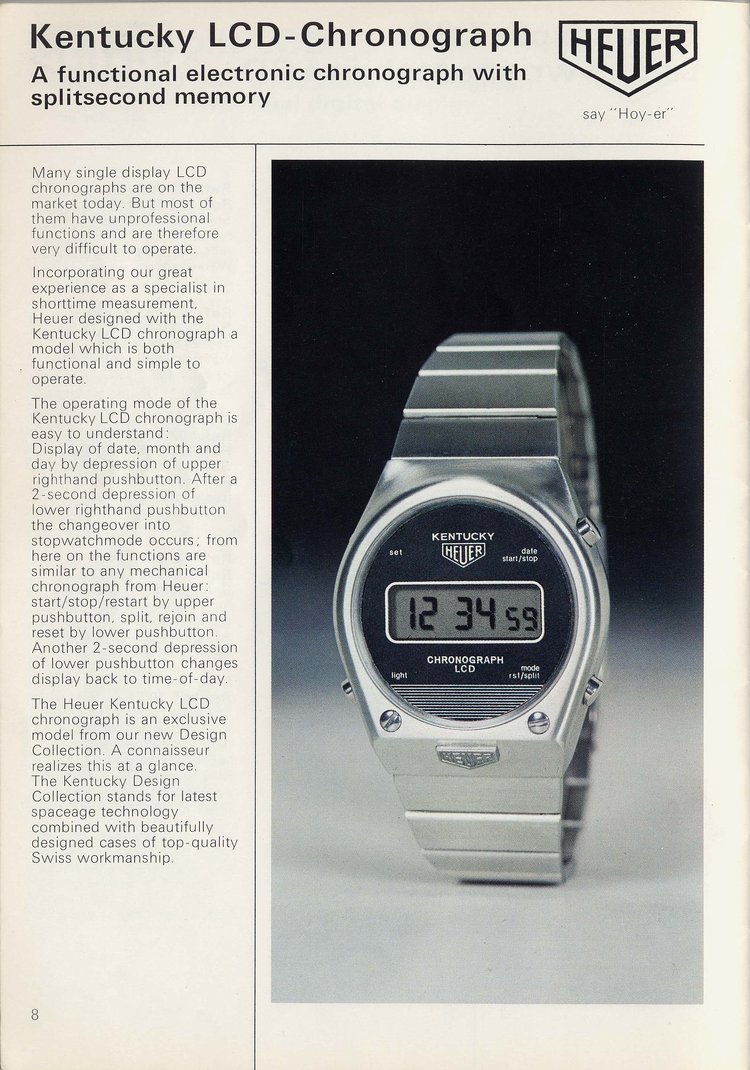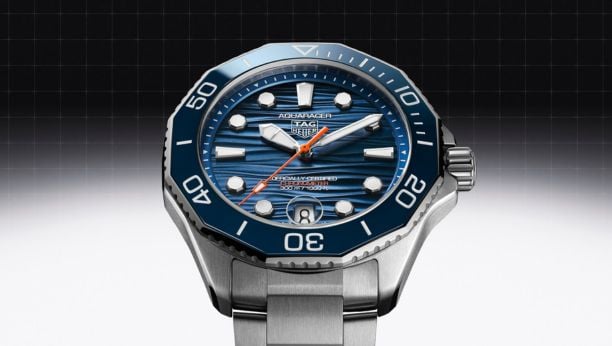VINTAGE COLLECTION
HEUER KENTUCKY
The Kentucky is a unique collection among the vintage Heuer chronographs. While we think of the Heuer chronographs of the 1960s and 70s as being associated with motorsports, the Kentucky was connected with a popular use of Heuer stopwatches and chronographs from the late 19th century – timing horse races. It was this connection that gave the Kentucky chronographs and watches their unique horseshoe shape.
The Kentucky occupied a pivotal point in the history of the Heuer brand, being the first major chronograph collection to be powered by the Valjoux 7750 movement (rather than the earlier Chronomatic (Calibre 12) automatic). The Kentucky would also look to the future, with a range of quartz-powered models, some with traditional hands and some with only digital screens for their delays
While most of Heuer’s classic 1960s and 70s chronographs were born with a strong motor racing identity, there were some exceptions, such as the Heuer Kentucky. As Heuer focused on increasing its sales in its largest market, the Kentucky was one of several models named after North American locations (Daytona, Memphis, Manhattan, Pasadena, Montreal), with the Camaro and Easy Rider also evoking American imagery. Still, naming a collection of chronographs and watches after the center of horseracing was legitimate for Heuer, as many of the brands earliest stopwatches and handheld chronographs in the 19th century were designed and used for the “sport of kings.”
Launched in 1977, the Kentucky chronograph also marked the beginning of Heuer’s transition from the Chronomatic (Calibre 12) line of movements to the Vajoux 7750 movements, as it was Heuer’s first major collection of mechanical chronographs since 1969 that didn’t use Heuer’s Chronomatic movement. The Valjoux 7750 series of movements would dominate the Swiss watch industry, and the movement and its successors would have a long history with Heuer, with the movement continuing in use to this day, now branded as the “Calibre 16”.
DESIGN
In his autobiography, Jack Heuer describes the background of the Kentucky design:
“We had designed the case for the “Kentucky” in the form of a horseshoe so the model would appeal to another client segment we were targeting, the horsey set, and its name was obviously chosen to conjure up thoughts of the annual Kentucky Derby. Personally I think this case was one of the nicest models we ever designed for a chronograph.”

CASE
Taking a close look at the case of the Kentucky, we see that what appears to be a fairly simple horseshoe shape is actually an intricate design, as the profile shots below demonstrate. The top part of the case towards the 12 o’clock position shares the same rounded “soft” form as the Daytona (which was also introduced in 1977), but as you move towards the base of the case the curves disappear into a bluff, angled wedge.
The overall effect gives the case the horseshoe shape to fit with the name, with the Heuer logo being mounted on the bottom facet of the case, adjacent to the top link of the bracelet, rather than on the dial. The case is finished with two screws toward the bottom of the upper-case, all of which combines to give the Kentucky a unique look.
DIAL
There are two Kentucky analogue dials, each quite different to the other.
The chronograph dial has the familiar layout of the Valjoux 7750 movement, with counters at 12 o’clock (chronograph minutes)-6 o’clock (chronograph hours)-9 o’clock (running seconds), and day-date windows at 3 o’clock. There are a single-set of lume dots, placed on the inside of the shortened hour-markers and a tachy scale on the flange. With the “Heuer” shield placed on the case, the “Kentucky” is the only chronograph of this era not to have the Heuer name on the dial. The main time-of-day hands (hours and minutes) have a relatively thin rectangular shape, with luminous and painted inserts, and match the style of the hour markers.
The quartz dial is relatively conventional, with the “Kentucky” name at the top, above the Heuer shield, with “QUARTZ” written across the bottom of the dial, above the date window. The narrow rectangular hands are typical of those used by Heuer in the late 1970s and are complemented by matching applied hour markers. The quartz dial has double lume dots- one set on the outer-edge of the hour markers, and then another set mounted on the flange/ rehaut.
THE HEUER KENTUCKY SERIES
The Kentucky series consists of three broad model types -- automatic chronograph, analogue quartz watch (which has traditional time-of-day hands) or and a digital quartz chronograph (with LCD displays), with all models sharing the same style case.
AUTOMATIC CHRONOGRAPH
The page below is from the 1978 Heuer catalogue and shows the four options in the chronograph range- two stainless steel models (Black or Blue dial) and two bi-metallic (gold and steel) models (Silver dial or Black).
KENTUCKY 750.703B
This model has a blue dial, in a stainless steel case.
KENTUCKY 750.705G
This model has a gray dial, in a bi-metallic case (stainless steel and gold).
KENTUCKY 750.705N
This model has a black dial, in a stainless steel case, with gold accents.
Kentucky 750.703N
This model has a black dial, in a stainless steel case.
QUARTZ ANALOGUE
By the time the Kentucky was launched, the impact of quartz watches was being fully felt by the Swiss watch brands, and many of the new watches introduced by Heuer offered quartz variants. The Kentucky was no exception, with both analogue (traditional hands) and digital display quartz models sold.
KENTUCKY 361.705G
This model features a gray dial, with gold accents and hands, and gold accents on the case.
KENTUCKY 361.705CH
This model has a champagne dial, with gold accents and hands, and gold accents on the case.
KENTUCKY 361.705N
This model has a black dial, with white accents and hands, and gold accents on the case.
DIGITAL QUARTZ
There were two versions of the Kentucky chronograph that had digital displays (i.e., there were no hands to indicate the time). Both these watches carry the marking “Assembled in Switzerland”, as the module for the digital movement was manufactured in the United States.
The reference 105.703 had a single LCD display screen, which displayed the time of day, and was also used for the chronograph (stopwatch) functions. The user could push a button to see the day, month and date.
The reference 102.713 – which was produced in more limited quantities -- had two LCD screens, with the top screen displaying the time of day and basic chronograph functions and the bottom screen also providing lap times (splits). HEUER KENTUCKY 102.713

HEUER KENTUCKY 105.703
MOVEMENTS
Announced in 1973 with watches launched the following year, the Valjoux 7750 is one of the legends of Swiss watchmaking. All the mechanical versions of the Kentucky use the Valjoux 7750 model, with the Kentucky being the first Heuer chronograph to be powered by this movement.
The Kentucky watches with analogue quartz displays (time-of-day hands) use the ESA 9362 module, a movement that Heuer also used on other three-hand quartz models of the same era (Carrera, Verona, etc.)
There two versions of the Kentucky with digital displays used two different movements The single-screen Kentucky used Heuer’s own Calibre 105 as shown below.
THE KENTUCKY BRACELET
The bracelet for the Kentucky is integrated with the case, being the same style as used on the Chronosplit and Manhattan models. With the Kentucky not having traditional lugs, the owner is not able to substitute a leather strap.
It was difficult for Heuer to produce the integrated bracelet for the Kentucky. Jack Heuer tells this story in his book:
“In 1977, our production was severely disrupted when two of our key suppliers unexpectedly went bankrupt…the other supplier which suddenly went bankrupt was La Centrale, an old established case-maker in Bienne. For years they had been amongst our regular suppliers and we had just given them the order to produce the cases for our new “Kentucky” chronograph…. The bankruptcy court authorised us to retrieve all the semi-finished “Kentucky” cases and I will never forget how one of my managers and I entered La Centrale’s gloomy, boarded-up factory to collect the cases. It was a spooky and very demoralising factory visit. We then took these half-finished cases to another of our case-makers and begged them to finish them. Of course they were not happy to do this, but we insisted and they eventually agreed.
When we finally received the finished cases we discovered a fault that caused the integrated bracelet to break off easily from the case and we had to return quite a few cases. We therefore made just a limited number of chronograph versions of the “Kentucky” and they are now much sought after by collectors. But we also used the same case to house a simple digital quartz movement so we could also have a lower-cost quartz watch in our range.”







